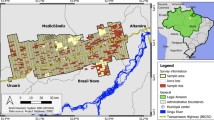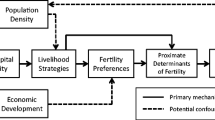Abstract
This paper seeks to broaden the application of demographyto environmental studies by complementing existing macro-level approaches, which feature aggregate populations, with a micro-level approach that highlights household life cycles. I take up the case of small farm households in the Brazilian Amazon to present a theoretical framework that identifies demographic characteristics which dispose families to engage in different forms of land use as household age structures change. Empirical models show that net of theeffects of farmer background, neighborhood context, institutional context, and off-farm incomes, demographic variables indicative of the household life cycle exert significant effects on the prominence of land uses with distinct environmental ramifications. The findings not only reveal micro-level demographic factors which affect Amazon land cover, they yield implications forfuture changes in rainforest landscapes in northern Brazil, and suggest household life cycle models as an avenue for further demographic research on environmental change in Latin America and other contexts.
Similar content being viewed by others
References
Aguirre, B.E., Saenz, R., Edmiston, J., Yang, N., Agramonte, E. & Stuart, D.L. (1993), The human ecology of tornadoes, Demography 30: 623–633.
Almeida, O.T., Veríssimo, A., Toniolo, A., Uhl, C., Mattos, M.M., Barreto, P. & Tarifa, R. (1996), A evolução da fronteira Amazônica, Belém: IMAZON.
Alston, L.J., Libecap, G.D. & Schneider, R. (1993), The settlement process, property rights, and land use on the Brazilian Amazon frontier: Preliminary results and lessons from US economic history. Presented at the All-University of California Economic History Conference, Pasadena, April 2–3.
Alston, L.J., Libecap, G.D. & Schneider, R. (1996), The determinants and impact of property rights: Land titles on the Brazilian Frontier. NBER Working Paper No. 5405.
Alston, L.J., Libecap, G.D. & Mueller, R. (1999), Titles, Conflict, and Land Use: The Development of Property Rights and Land Reform on the Brazilian Amazon Frontier, Ann Arbor: University of Michigan Press.
Arzipe, L., Stone, M.P. & Major, D.C., eds (1994), Population and Environment, Boulder: Westview Press.
Bongaarts, J. (1992), Population growth and global warming, Population and Development Review 18: 299–319.
Bongaarts, J. (1996), Population pressure and the food supply system in the developing world, Population and Development Review 23: 483–503.
Boserup, E. (1965), The Conditions of Agricultural Growth, London: Allen and Unwin.
Boserup, E. (1981), Population and Technological Change, Chicago: University of ChicagoPress.
Cohen, J.E. (1995), How Many People can the Earth Support? New York: W.W. Norton andCo.
Davis, K. & Bernstam, M.S., eds (1991), Resources, Environment and Population, NewYork: Oxford University Press.
Dufour, D. (1990), Use of tropical rainforests by native Amazonians, BioScience 40: 652–659.
Ehrlich, P. & Ehrlich, A. (1990), The Population Explosion, New York: Simon and Schuster.
Ellis, F. (1993), Peasant Economics, 2nd edn, Cambridge: Cambridge University Press.
Fearnside, P.M. (1990), Environmental destruction in the Brazilian Amazon, pp. 171–220 in D. Goodman & A. Hall (eds), The Future of Amazonia, London: St. Martin's Press.
Gash, J.H.C., Nobre, C., Roberts, J.M. & Victoria, R.L., eds (1996), Amazonian Deforestation and Climate Change, Chichester: John Wiley and Sons.
Godoy, R., O'Neill, K., Groff, S., Kostishack, P., Cubas, A., Demmer, J., McSweeney, K., Overman, J., Wilkie, D., Brokaw, N. & Martinez, M. (1997a), Household determinants of deforestation by Amerindians in Honduras, World Development 25: 977–987.
Godoy, R., Wilkie, D. & Franks, J. (1997b), The effects of markets on neotropical deforestation: A comparative study of four Amerindian societies, Current Anthropology 38: 875–878.
Godoy, R., Groff, S. & O'Neill, K. (1998a), The role of education in neotropical deforestation: Household evidence from Amerindians in Honduras, Human Ecology 26: 649–675.
Godoy, R., Jacobson, M., De Castro, J., Aliaga, J., Romero, J. & Davis, A. (1998b), The role of tenure security and private time preference in neotropical deforestation, Land Economics 74: 162–170.
Godoy, R., Jacobson, M. & Wilkie, D. (1998c), Strategies of rain-forest dwellers against misfortunes: The Tsimane Indians of Bolivia, Ethnology 37: 55–69.
Green, C.P. (1992), The environment and population growth: Decade for action, Population Reports Series M, No. 10.
Hogan, D. (1992). Migration dynamics, environmental degradation and health in São Paulo, pp. 279–299, in Veracruz 1992: El poblamiento de las Américas, Proceedings of the 1992 IUSSP Meetings, Vol. 2.
Hunter, L.M. (1998), The association between environmental risk and internal migration flows, Population and Environment 19: 247–277.
Instituto Brasileiro de Geografia e Estatística (IBGE) (1983), Censo demográfico – 1980: Dados gerais, Rio de Janeiro: IBGE.
IBGE (1990), Censo agropecuário – 1985, IBGE, Rio de Janeiro.
IBGE (1996), Censo demográfico – 1991: Características da população e instrução, Rio de Janeiro: IBGE.
IBGE (1998a), Contagem populacional de 1996. Available at IBGE website, http://www.ibge.org, June.
IBGE (1998b), Censo agropecu rio 1995/96. Available at IBGE website, http://www.ibge.org, June.
Instituto de Desenvolvimento do Estado do Pará (IDESP) (1990), Uruará, Belém: IDESP.
INPE (Instituto Nacional de Pesquisas Espaciais) 2000, Desmatamento da Amazônia Brasleira, 1998–1999, Available at INPE website, http://www.inpe.br/Informacoes_Eventos/amz1998_1999/pagina7.htm, May.
Jolly, C. (1994), Four theories of population change and the environment, Population and Environment 16: 61–90.
Jones, D.W., Dale, V.H., Beauchamp, J.J., Pedlowski, M.A. & O'Neill, R.V. (1995), Farming in Rondnia., Resource and Energy Economics 17: 155–188.
Jordan, C.F. (1986), Local effects of tropical deforestation, pp. 410–426 in M. Soulé, (ed.), Conservation Biology, Sutherland: Sinauer Associates.
Kates, R.W. (1996), Population, technology and the human environment: A thread through time, Daedalus 125: 43–71.
Keyfitz, N. (1991), Population and development within the ecosphere: One view of the literature, Population Index 57: 5–22.
Lutzenheiser, L. & Hackett, B. (1993), Social stratification and environmental destruction: Understanding household CO2 production, Social Problems 40: 50–73.
MacKellar, F.L., Lutz, W., McMichael, A.J., Suhrke, A., Mishra, V., O'Neill, B., Prakeesh, S. & Wexler, L. (1998), Population and climate change, pp. 89–193 in S. Rayner and E.L. Malone (eds), Human Choice and Climate Change, Vol. 1: The Societal Framework, Columbus: Battelle Press.
Marquette, C.M. (1998), Land use patterns among small farmer settlers in the Northeastern Ecuadorian Amazon, Human Ecology 26: 573–593.
Mazur, L.A., ed. (1994), Beyond the Numbers, Washington, DC: Island Press.
McCracken, S.D., Brondizio, E.S., Nelson, D., Moran, E.F., Siqueira, A.D. & Rodriguez-Pedraza, C. (1999), Remote sensing and GIS at farm property level: Demography and deforestation in the Brazilian Amazon, Photogrammetric Engineering and Remote Sensing 65: 1311–1320.
Moran, E.F. (1989), Adaptation and maladaptation in newly settled areas, pp. 20–41 in D. Schumann and W. Partridge (eds), The Human Ecology of Tropical Land Settlement in Latin America, Boulder: Westview Press.
Murphy, L. (2000), Land use and deforestation by migrant colonists in the Amazon: Permanence and adaptation. Paper presented at the XXII meetings of the Latin American Studies Association, Miami, March 16–18.
Nepstad, D., Uhl, C. & Serrão, E.A.S. (1991), Recuperation of a degraded Amazonian landscape: Forest recovery and agricultural restoration, Ambio 20, 248–255.
Nepstad, D., Veríssimo, A., Alencar, A., Nobre, C., Lima, E., Lefebvre, P., Schlesinger, P., Potter, C., Moutinho, P., Mendoza, E., Cochrane, M. & Brooks, V. (1999), Large-scale impoverishment of Amazonian forests by logging and fire, Nature 398: 505–508.
Ness, G.D., Drake, W.D. & Brechin, S.R., eds (1993), Population-environment dynamics, Ann Arbor: University of Michigan.
Netting, R. McC. (1993), Smallholders, householders, Stanford University Press, Stanford.
O'Lear, S. (1997),Migration and the environment: A review of recent literature, Social Science Quarterly 78: 606–618.
Ozorio de Almeida, A.L. & Campari, J.S. (1995), Sustainable Settlement in the Brazilian Amazon, Oxford: Oxford University Press.
Panayotou, T. (1996), An inquiry into population, resources, and environment, pp. 259–298 in D.A. Ahlburg, A.C. Kelley & K. Oppenheim Mason (eds), The Impact of Population Growth on Well-Being in Developing Countries, New York: Springer-Verlag.
Pebley, A.R. (1998), Demography and the environment, Demography 35: 377–389.
Perz, S.G. (2001a), From sustainable development to ‘productive conservation’: Forest conservation options and agricultural income and assets in the Brazilian Amazon, Rural Sociology 66: 93–112.
Perz, S.G. (2001b), Population growth and net migration in the Brazilian legal Amazon, 1970– 1996, forthcoming in C.H. Wood & R. Porro (eds), Land Use and Forest Change in the Brazilian Amazon, Gainesville: University of Florida Press.
Pichón, F.J. (1996a), Settler agriculture and the dynamics of resource allocation in frontier environments, Human Ecology 24: 341–371.
Pichón, F.J. (1996b), Land-use strategies in the Amazon Frontier: Farm-level evidence from Ecuador, Human Organization 55: 416–424.
Pichón, F.J. (1996c), The forest conversion process: A discussion of the sustainability of predominant land uses associated with frontier expansion in the Amazon, Agriculture and Human Values 13: 32–51.
Pichón, F.J. (1997), Colonist land-allocation decisions, land use, and deforestation in the Ecuadorian Amazon frontier, Economic Development and Culture Change 45: 707–744.
Preston, S.H. (1996), The effects of population growth on environmental quality, Population Research and Policy Review 15: 95–108.
Rudel, T.R. & Horowitz, B. (1993), Tropical Deforestation: Small Farmers and Land Clearing in the Ecuadorian Amazon, New York: Columbia.
Serrão, E.A.S. & Homma, A.K.O. (1993), Brazil, pp. 265–351 in Sustainable Agriculture and the Environment in the Humid Tropics, Washington: National Academy Press.
Serrão, E.A.S. & Toledo, J.M. (1991), The search for sustainability in Amazonian pastures, pp. 195–213 in A.B. Anderson (ed.), Alternatives to Deforestation, New York: Columbia University Press.
Skole, D.L. & Tucker, C.J. (1993), Tropical deforestation and habitat fragmentation in the Amazon: Satellite data from 1978 to 1988, Science 260: 1905–1910.
Smail, J.K. (1997), Beyond population stabilization: The case for dramatically reducing global human numbers, Politics and the Life Sciences 16: 183–192.
Smil, V. (1994), How many people can earth feed?, Population and Development Review 20: 255–292.
Smith, S.K. & McCarty, C. (1996), Demographic effects of natural disasters: A case study of hurricane Andrew, Demography 33: 265–275.
Sydenstricker Neto, J. & Vosti, S.A. (1993), Household Size, Sex Composition, and Land Use in Tropic Moist Forests: Evidence from the Machadinho Colonization Project, Rondonia, Brazil, unpublished manuscript.
Thorner, D., Kerblay, B. & Smith, R.E.F., eds (1986), A.V. Chayanov on the Theory of Peasant Economy, Madison: University of Wisconsin Press.
Tiffen, M. & Mortimore, M. (1994). Malthus controverted: The role of capital and technology in growth and environment recovery in Kenya, World Development 22(7): 997–1008.
Tourrand, J.-F., Veiga, J.B., Simão-Neto, M., Vale, W.G., Ferreira, L.A., Ludovino, R.R. & Mares Guia, A.P.O. (1996), Animal Husbandry in Agricultural Frontiers of the Brazilian Amazon, Belém, unpublished manuscript.
Turner, B.L.II, Skole, D., Sanderson, S., Fischer, G., Fresco, L. & Leemans, R. (1995), Land-Use and Land-Cover Change Science/Research Plan, Stockholm and Geneva: IGBP/HDP.
United Nations (1994), Population, Environment and Development, Proceedings of the UN Working Expert Group Meetings on Population, Environment and Development, UN Headquarters, 20–24 Jan. 1992, New York: UN.
Walker, R.T. & Homma, A.K.O. (1996), Land use and land cover dynamics in the Brazilian Amazon: An overview, Ecological Economics 18: 67–80.
Walker, R.T., Perz, S.G., Caldas, M. & Teixeira da Silva, L.G. (2001), Land use and land cover change in forest frontiers: The role of household life cycles, manuscript under review for publication.
Wood, C.H. & Walker, R.T. (2000), Tenure Security, Investment Decisions and Resource Use among Small Farmers in the Amazon, unpublished manuscript.
Author information
Authors and Affiliations
Rights and permissions
About this article
Cite this article
Perz, S.G. Household demographic factors as life cycle determinants of land use in the Amazon. Population Research and Policy Review 20, 159–186 (2001). https://doi.org/10.1023/A:1010658719768
Issue Date:
DOI: https://doi.org/10.1023/A:1010658719768




